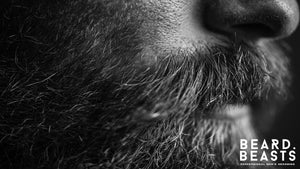How to Get Rid of Beard Dandruff: Effective Solutions
Beard dandruff. Just the words can make a beard enthusiast cringe. Those pesky white flakes can ruin an otherwise perfect beard, making it look unkempt and itchy. But don't despair! Learning how to get rid of beard dandruff is easier than you think. This guide breaks down the causes, symptoms, and, most importantly, the solutions to help you achieve a healthy, flake-free beard you can be proud of. Whether you're a seasoned beardsman or just starting out, these tips will help you conquer those flakes and rock a confident style.
Causes of Beard Dandruff
So, what exactly causes those annoying flakes? Understanding the root causes of beard dandruff is the first step to banishing them for good. While it might seem like a simple issue, identifying the specific culprit will help you tailor your approach and achieve lasting results. Here are some of the main reasons why beard dandruff occurs:

Dry Skin Beneath the Beard:
Just like the skin on your face, the skin under your beard needs moisture. When it doesn't get enough, it becomes dry, itchy, and flaky – the perfect recipe for beard dandruff. Growing a beard can actually exacerbate this problem, as it can make it harder for your natural skin oils (sebum) to reach the surface. Regularly moisturizing the skin beneath your beard is essential to combat dryness and prevent flakes.
Poor Beard Care Routine or Hygiene:
Your beard can easily trap dirt, sweat, oil, and even food particles. Without a proper cleaning routine, this buildup creates an ideal breeding ground for flakes and irritation. Washing your beard two to three times a week with a gentle cleanser designed specifically for facial hair is crucial. Consistent grooming removes buildup and keeps your beard fresh and healthy.
Excessive Use of Harsh Beard Products:
Some beard products, especially those containing alcohol or harsh synthetic fragrances, can do more harm than good. These harsh ingredients can strip your skin of its natural oils, leading to dryness, irritation, and – you guessed it – dandruff. Opt for products specifically formulated for beards, focusing on those with natural and hydrating ingredients like argan oil or jojoba oil.
Skin Conditions Like Eczema or Fungal Infections:
In some cases, beard dandruff can be a symptom of an underlying skin condition such as seborrheic dermatitis, eczema, or a fungal infection. These conditions can cause excessive skin shedding and irritation, leading to noticeable flakes. If over-the-counter remedies don't provide relief, it's best to consult a dermatologist. They can diagnose the specific condition and recommend appropriate treatment, which may include medicated shampoos or creams.
By understanding these potential causes, you’re one step closer to learning how to get rid of beard dandruff. Combining proper grooming, using the right products, and addressing any underlying skin issues will result in a healthier, flake-free, and more attractive beard.
Signs and Symptoms of Beard Dandruff
How do you know if you're dealing with beard dandruff? Recognizing the signs is the first step to tackling the problem head-on. Catching these early indicators allows you to adjust your beard care routine and effectively manage those pesky flakes. Here are the most common symptoms to watch out for:

Visible Flakes in Your Beard:
This is the most obvious sign: those telltale white flakes clinging to your beard or dusting your shirt. They're especially noticeable on darker clothing and, let's be honest, can be a bit embarrassing. The good news? Regular cleansing and exfoliation can significantly reduce these flakes and restore a clean, polished look.
Itchiness or Irritation Under the Beard:
An itchy, tight, or irritated feeling beneath your beard is a strong indicator of dryness or buildup. Resist the urge to scratch, as this can worsen the problem, leading to redness and even more flaking. Applying a quality beard oil or balm can soothe the irritation and hydrate the skin, providing much-needed relief.
Dry or Flaky Skin Beneath the Beard:
Take a closer look at the skin under your beard. Do you see dry patches or peeling skin? This dryness is a major contributor to flake formation. Using a beard-specific moisturizer will hydrate both your beard and the underlying skin, helping to alleviate this dryness.
Redness or Inflamed Skin:
In some cases, beard dandruff can cause redness or inflammation, especially if it's related to a skin condition like seborrheic dermatitis or eczema. If redness persists despite a consistent beard care routine, it's advisable to consult a dermatologist for professional advice.
Dull or Lifeless Beard Hair:
A flaky, unhealthy beard often looks dry and lacks shine. This is usually a sign of inadequate care and hydration. Regular conditioning can significantly improve the look and feel of your beard, making it softer, shinier, and more manageable.
By being aware of these signs and symptoms, you'll be better equipped to manage beard dandruff. Whether it's tweaking your grooming routine or choosing the right products, addressing these symptoms early will lead to a healthier, more attractive beard.
Preventive Measures: Keeping Beard Dandruff at Bay
So, you've tackled the flakes – great! Now, the key is to prevent them from making a comeback. A consistent and effective beard care routine is crucial for maintaining a healthy, flake-free beard. Here’s how to keep beard dandruff at bay:

Establish a Solid Beard Care Routine:
A good grooming routine is the foundation of a healthy beard. Regular cleansing, exfoliating, and moisturizing can work wonders in preventing the buildup of dead skin and dryness that leads to flakes.
- Cleansing: Wash your beard two to three times a week with a gentle, sulfate-free beard shampoo. This removes dirt, sweat, and excess oil without stripping away essential moisture.
- Exfoliating: Use a soft-bristled beard brush to gently exfoliate the skin beneath your beard. This helps remove dead skin cells and promotes healthy circulation.
- Moisturizing: Apply a beard oil or beard butter daily to lock in moisture and nourish both the hair and skin. Look for products with natural ingredients like argan oil or jojoba oil.
By sticking to a regular routine, you'll not only prevent beard flakes but also enjoy a softer, healthier-looking beard.
Stay Hydrated (Inside and Out):
Hydration is key for healthy skin and a healthy beard. Dehydrated skin is much more prone to dryness and flaking, which can contribute to beard dandruff.
- Drink Up: Aim for at least eight glasses of water a day to keep your skin hydrated from the inside out.
- Use Hydrating Products: Incorporate hydrating products like beard oils, balms, and conditioners. Look for ingredients like shea butter or glycerin for an extra boost of moisture.
Staying hydrated improves skin elasticity, reduces dryness, and keeps your beard looking its best.
Avoid Irritants:
Certain products can irritate your skin and do more harm than good, especially those containing harsh chemicals or ingredients that strip your beard of its natural oils.
- Choose Gentle Products: Stick to products specifically formulated for beards. Regular body soap or shampoo can be too harsh for the delicate skin underneath.
- Be Mindful of Fragrances: Opt for unscented or lightly scented products, as strong synthetic fragrances can irritate sensitive skin.
- Patch Test: Before using a new product all over your beard, do a small patch test to check for any adverse reactions.
By avoiding irritants, you'll protect your skin's natural balance and minimize the chances of dandruff.
Taking these preventive measures will help you maintain a healthy, flake-free beard. A consistent grooming routine, proper hydration, and avoiding irritants are the best ways to keep your beard looking and feeling great.
A Step-by-Step Guide to Banishing Beard Dandruff
Ready to say goodbye to beard dandruff for good? This simple step-by-step guide will show you how to effectively tackle those flakes and maintain a healthy, handsome beard:

Cleanse Your Beard Regularly:
Regular cleansing is the cornerstone of good beard care. Washing your beard removes dirt, sweat, and excess oil that can contribute to dandruff.
- How: Wash your beard two to three times a week with a gentle, sulfate-free beard shampoo. This cleanses without stripping away essential oils.
- Product Tip: Look for shampoos with natural ingredients like tea tree oil or aloe vera, known for their soothing and anti-inflammatory properties.
Exfoliate for a Flake-Free Foundation:
Exfoliation is key to removing dead skin cells and unclogging pores, preventing buildup that leads to visible flakes.
- How: Use a beard brush or a gentle exfoliating scrub designed for facial hair. Gently massage the skin in circular motions.
- Benefit: Exfoliation not only removes flakes but also promotes healthier hair growth by clearing blocked follicles.
Moisturize and Condition for a Soft, Healthy Beard:
Dry skin is a major culprit in beard dandruff, so hydration is essential. Regular moisturizing keeps your beard soft, manageable, and flake-free.
- Best Products: Look for beard oils with hydrating ingredients like argan oil, jojoba oil, or vitamin E. A beard balm can provide extra moisture and light hold.
- How to Apply: After washing and drying your beard, massage a few drops of oil into the skin and work it through your beard. Follow with balm for extra hydration and styling.
Treat Persistent Dandruff (If Necessary):
If regular care doesn't do the trick, you might need a stronger approach. Persistent dandruff can sometimes be linked to underlying skin conditions.
- Over-the-Counter Options: Consider antifungal shampoos or medicated creams containing ingredients like ketoconazole or selenium sulfide. These can target the root cause of dandruff.
- When to See a Dermatologist: If over-the-counter treatments don't work, or if you suspect a skin condition, consult a dermatologist for personalized advice.
By following these steps, you'll be well on your way to a healthy, flake-free beard. Consistency is key, so stick with your routine for best results.
Long-Term Tips for a Healthy Beard and Skin
Keeping beard dandruff at bay isn't just about quick fixes; it's about adopting healthy habits for long-term beard and skin health. Here are some practical tips to keep your beard looking and feeling its best:

Fuel Your Beard from Within (Maintain a Balanced Diet):
What you eat has a direct impact on your skin and beard. A diet rich in essential nutrients helps your body produce the natural oils that keep your skin hydrated and your beard healthy.
-
Focus on incorporating foods rich in:
- Omega-3 fatty acids (found in fish, walnuts, and flaxseeds) to reduce dryness.
- Vitamin E (found in almonds and spinach) to nourish and protect skin.
- Biotin (found in eggs and avocados) to promote healthy beard growth.
A nutrient-rich diet supports a dandruff-free beard and improves your skin’s overall texture and tone.
Manage Stress for a Healthy Beard and Skin:
Stress can wreak havoc on your skin, leading to dryness, irritation, and dandruff flare-ups. High stress levels can also worsen conditions like seborrheic dermatitis.
-
Try these stress-busting tips:
- Incorporate regular exercise to improve circulation and reduce stress.
- Practice mindfulness techniques like meditation or deep breathing.
- Prioritize quality sleep for skin repair and rejuvenation.
Keeping stress in check benefits both your skin and beard health.
Stick to a Consistent Beard Grooming Routine:
Consistent grooming is essential for preventing flakes and maintaining a well-groomed beard.
-
Key Practices:
- Brush Regularly: Use a soft-bristled beard brush to distribute natural oils and prevent buildup.
- Cleanse, Exfoliate, and Moisturize: Stick to your routine to keep dryness and flakes at bay.
- Trim as Needed: Regular trims prevent beard split ends and keep your beard looking neat.
A little daily effort goes a long way in keeping your beard healthy and dandruff-free.
Hydrate, Hydrate, Hydrate:
Hydration is crucial for healthy skin and a healthy beard. Drinking plenty of water helps keep your skin supple and reduces the risk of dryness, a major cause of beard dandruff.
-
Hydration Hacks:
- Aim for at least eight glasses of water daily.
- Use a humidifier, especially in dry climates.
Proper hydration contributes to a softer, more manageable beard and addresses the root causes of dandruff.
By focusing on these long-term strategies, you'll maintain a beard that reflects health and confidence. Taking care of your beard is about more than just appearances—it's about fostering good habits that benefit your overall well-being.
Conclusion
Dealing with beard dandruff can be frustrating, but it's absolutely manageable. By understanding the causes, recognizing the signs, and establishing a consistent care routine, you can effectively banish those flakes and achieve a healthier, more confident look.
Here's a quick recap of the key takeaways:
- Build a regular beard care routine: cleanse, exfoliate, and moisturize consistently.
- Stay hydrated: drink plenty of water and use nourishing beard products.
- Avoid harsh products: choose gentle, beard-specific formulas.
- Seek professional help: if persistent issues arise, consult a dermatologist.
A clean, flake-free beard not only looks great but also boosts your self-esteem. By implementing these tips, you'll keep your beard in top condition, making it a key feature of your style. Start today and enjoy the rewards of a healthier, more polished, and dandruff-free beard.








